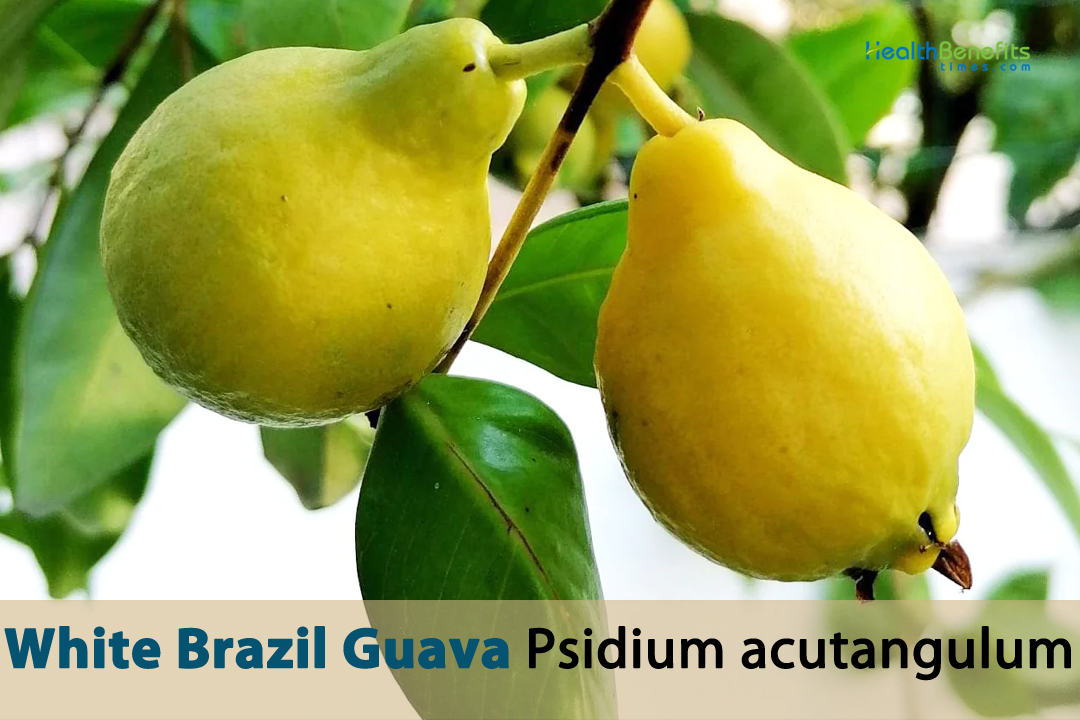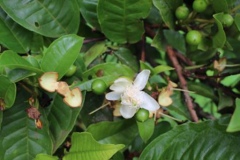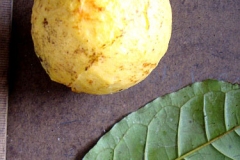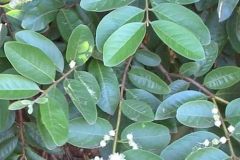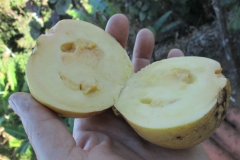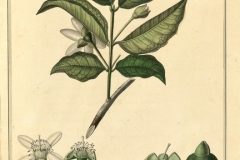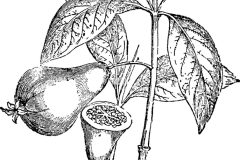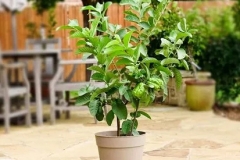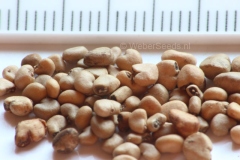People think that the name “Psidium” comes from the Greek word “psidion,” which means “pomegranate,” because some guava fruits look like pomegranates. The name “acutangulum” is a special name that comes from Latin words. The word “acuta” means “sharp” or “pointed,” which refers to the sharp or pointed curves that can be seen in the plant’s leaves and other parts. The word “angulum” means “angle,” which means that the plant has distinct angles or angular parts, like in its leaves or flowers. The fruits can be eaten, and people in the area take them from the wild and eat them. The native people of the Amazon have been growing this tree for a long time. It is still sometimes grown for its fruit at low to medium levels in different parts of South America. It is also sometimes grown as an ornamental plant.
White Brazil Guava Facts
| White Brazil Guava Quick Facts | |
|---|---|
| Name: | White Brazil Guava |
| Scientific Name: | Psidium acutangulum |
| Origin | Tropical Central and South America, such as Costa Rica, Panama, Colombia, French Guiana, Guyana, Suriname |
| Colors | Pale green when unripe to pale yellow to yellow when ripe |
| Shapes | Round, pear-shaped or ellipsoid, 3–8 cm across, glabrous, with persistent calyx remnants at the apical end |
| Taste | Wonderful fusion of sweetness, tartness, tropical nuances |
| Major nutrients | • Vitamin C • Dietary Fiber • Vitamin A • Vitamin B Complex • Potassium • Antioxidants • Minerals • Vitamin K • Folate • Iron • Vitamin E • Manganese |
| Health benefits | Boosts Immune System, Heart Health, Blood Sugar Regulation, Vision Protection, Skin Nourishment, Cancer Prevention , Bone Health, Weight Management, Reduces Allergy Symptoms, Respiratory Health, Hair Health, Menstrual Health, Liver Health, Enhanced Blood Circulation, Joint Health, Dental Health Aids in Anemia Prevention |
| Name | White Brazil Guava |
|---|---|
| Scientific Name | Psidium acutangulum |
| Native | Tropical south America (French Guiana, Guyana, Suriname, Venezuela, Bolivia, Ecuador, Peru, Belize and Brazil) |
| Common Names | White Brazilian Guava, Brazilian White Guava, White Guava, White Flesh Guava, Snow White Guava, Pearl Guava, Creamy White Guava, Blanco Guava, Ivory Guava, Pale Guava, Alabaster Guava, Milk Guava, Frosty Guava, Vanilla Guava, Snowball Guava, Snowy Guava, Arctic Guava, Milky Way Guava, Pearly White Guava, White Diamond Guava, Crystal Guava, Frostbite Guava, Ivory Cream Guava |
| Name in Other Languages | Afar: White Brazil Guava Afrikaans: Wit Brasiliaanse Guava Albanian: Guava e Bardhë e Brazilisë Amharic: Ye Brazil Brazil Gwaat (የብራዚል ብራዚል ጓያት) Arabic: Guaba Brazil Bayda (جوافة برازيل بيضاء), Juafa Bayda min al-Brazil (جوافة بيضاء من البرازيل) Armenian: Belaziakan spitak huava (Բելազիական սպիտակ հուավա) Azerbaijani: Ağ Braziliya Guava Bengali: Shada Brazil Guava (সাদা ব্রাজিল গুয়াবা) Bolivia : Guabira Brazil : Araçá Comum Do Pará, Araçá Do Pará, Araçá-Piranga, Araçá Pomba, Araçándiva, Araçanduba, Goia-Ba-Do-Pará, Bulgarian: Byala brazil’ska guava (Бяла бразилска гуава) Catalan: Guaiava Blanca del Brasil Chinese: Bāxī bái fānshíliú (巴西白番石榴), Jiān guǒ fān shíliú (尖果番石榴) Croatian: Bijela brazilska guava Czech: Bílá Brazilská Guava Danish: Hvid Brasiliansk Guava Dutch: Witte Braziliaanse Guave, Coronilla English: White Brazil Guava Estonian: Valge Brasiilia Guava Filipino: Puting Guava ng Brazil, Puting Brazil Guava Finnish: Valkoinen Brasilian Guava French: Goyave Blanche du Brésil, Guava Blanche du Brésil Georgian: Tetri brazilis guava (თეთრი ბრაზილიის გუავა) German: Weiße Brasilianische Guave, Para-Guave Greek: Aspro Vraziliko Goýa (Άσπρο Βραζιλικό Γκουάβα), Lefkí Braziliániki Gouáva (Λευκή Βραζιλιάνικη Γουάβα), Levkí Gkoúava tis Brazílias (Λευκή Γκουάβα της Βραζιλίας) Haitian Creole: Guava Bresilyen Blan Hebrew: Guava Brazilit Lavan (גוואבה ברזילית לבן), Guava Brazilit Levana (גוואבה ברזילאית לבנה) Hindi: Safed Brazil Guava (सफ़ेद ब्राज़िल ग्वावा), Safed Brazil Amrood (सफेद ब्राज़िल अमरूद) Hungarian: Fehér Brazil Guava Icelandic: Hvít Brásílísk Guava Igbo: White Brazil Guava Indonesian: Guava Brasil Putih Irish: Guáva Bhrasaíleach Bhán Italian: Guava Bianca del Brasile Japanese: Howaito Burajiru Guaba (ホワイトブラジルグアバ) Javanese: Guava Brazil Putih Kazakh: Aq Brazilïya guavasy (Ақ Бразилия гуавасы) Khmer: Krɑlɑnh pɑnh broelii (ក្រឡាញ់ពណ៌ប្រែលី) Korean: Hwaiteu Beurajil Guaba (화이트 브라질 구아바) Lao: Kūay barāmī lī (ກ້ວຍບຣາມີລີດ) Latvian: Baltais Brazīlijas Guava Lithuanian: Baltoji Brazilijos Guava Macedonian: Bela brazilska guava (Бела бразилска гуава) Malagasy: Guava Brazil Mainty Malay: Jambu Guava Putih Brazil, Guava Brazil Putih Marathi: Shwet Brazil Jambhul (श्वेत ब्राझिल जांभुळ), Pāṇḍharī Brazil Jāṃbhul (पांढरी ब्राझिल जांभुळ) Maltese: Gwava Bajda tal-Brażil Nepali: Seto Brazil Gwava (सेतो ब्राजिल ग्वावा) Nigerian Pidgin: White Brazil Guava Norwegian: Hvit Brasiliansk Guava Pashto: Sped Brazilai Guava (سپید برازیلی ګواوا) Persian: Guava Sefīd-e Brāzīlī (گواوا سفید برازیلی), Guava-ye Safid-e Brazil (گواوا سفید برزیلی) Peru : Ampiyacu, Guayaba De Agua, Puca Yacu Polish: Biała Gujawa Brazylijska Portuguese: Goiaba Branca do Brasil, Araçá comum do Pará, Araçá do Pará, Araçá pomba, araçá, araçá-boi, araçá-goiaba, goiabarana, Araçá-pera Romanian: Guava Albă din Brazilia Russian: Belaya brazil’skaya guava (Белая бразильская гуава) Samoan: Guava Brazil ‘Uli’uli Serbian: Bela brazilska guava (Бела бразилска гуава) Shona: White Brazil Guava Slovak: Biela brazílska guava Slovenian: Bela Brazilija Guava Somali: White Brazil Guava Spanish: Guayaba Blanca de Brasil, White Brazil Guava, Ampiyacu, Guabira, Guayaba de agua, Puca yacu Swahili: Guava ya Brazil Nyeupe, Guava Brazil Nyeupe Swedish: Vit Brasiliansk Guava Tajik: Guavai Safed Brazilia (Гуаваи Сафед Бразилия) Tamil: Veḷḷai Pirēcil Koyyā (வெள்ளை பிரேசில் கொய்யா) Telugu: Wait Brejil Gwava (వైట్ బ్రెజిల్ గ్వావా), Vellutūrpu Brazil Guvāva (వెల్లుతూర్పు బ్రజిల్ గ్వావ) Thai: Guava Khao Brazil (กวาวาขาวบราซิล) Turkish: Beyaz Brezilya Guavası Ukrainian: Bila brazil’s’ka huava (Біла бразильська гуава) Urdu: Safaid Brazil Amrood (سفید برازیل امروڈ) Uzbek: Oq Braziliya Guava Vietnamese: Ổi Trắng Brazil (Ổi Trắng Brazil) Welsh: Guava Frazil Wen Xhosa: White Brazil Guava Yoruba: White Brazil Guava Zulu: Iguava Brazil Bhulu |
| Plant Growth Habit | Small to medium-sized evergreen shrub or tree |
| Growing Climates | Found in savannas, grasslands, moist upland forests and disturbed areas |
| Soil | Plant does best in well-draining soil. They prefer slightly acidic to neutral soil with a pH range of 5.0 to 7.0. Sandy loam or loamy soil types are ideal for the plant growth |
| Plant Size | 3 – 12 meters tall with crooked bole 15 – 25 cm in diameter |
| Root | Plant has taproot. The taproot gives rise to numerous smaller roots known as secondary or lateral roots. These lateral roots branch out horizontally from the taproot and extend into the surrounding soil |
| Stem | Main stem is usually referred to as the trunk. It grows vertically from the ground and supports the entire plant’s architecture. The trunk is responsible for bearing the weight of branches, leaves, flowers, and fruits |
| Bark | The outermost layer of the bark is the epidermis which may have a layer of waxy cuticle to minimize water loss through transpiration |
| Leaf | Leaves are borne on very short 1 cm petioles, broadly elliptical, 10–14 cm long by 4–6 cm wide, rounded at the base, apex acuminate with distinct mid rib and 6–9 pairs of secondary veins conspicuous on the underside |
| Flowering season | March to June |
| Flower | Flowers solitary or in fascicles of 2–3 flowers in leaf axils. Flowers on long peduncle with green sepals, 5 white –petals and numerous white, long, thin stamens |
| Fruit Shape & Size | Round, pear-shaped or ellipsoid, 3–8 cm across, glabrous, with persistent calyx remnants at the apical end |
| Fruit Color | Pale green when unripe to pale yellow to yellow when ripe |
| Flesh Color | Translucent yellowish-white |
| Seed | Hard, triangular seeds |
| Flavor/Aroma | Delightful blend of tropical and fruity notes |
| Taste | Wonderful fusion of sweetness, tartness, tropical nuances, and a touch of creaminess |
| Plant Parts Used | Leaves, fruits, seeds, barks and roots |
| Propagation | By seeds, semi-hardwood cuttings, Air Layering |
| Lifespan | Can live anywhere from 30 to 40 years or more |
| Season | August to November |
| Varieties |
|
| Major Nutrition |
|
| Available Forms |
|
| Health benefits |
|
Plant Description
White Brazil Guava is a small to medium-sized evergreen shrub or tree that can grow between 3 and 12 meters tall and has a small, sparse head. The size of the crooked bole can range from 15 to 25 cm. The plant has many branches and grows in a way that makes it thick and spread out. In its original range, the plant grows in savannas, grasslands, moist upland forests, and places that have been changed. It does best in warm, tropical regions and can grow in a variety of soils. The plant does well in places where there are clear wet and dry seasons. Soil that drains well is best for the plant. They like dirt with a pH between 5.0 and 7.0, which is slightly acidic to neutral. The best kind of soil for plants to grow in is sandy loam or loamy soil.
Traditional medicine uses different parts of the plant, like the leaves and flowers, because they may be good for your health. Ripe fruits are eaten both fresh and after being cooked. Because they taste good, they are often used to make jams, sauces, and drinks. The fruits can also be used as a garnish or in sweets and salads. The fruit is also a food source for birds and cats, among other animals. Because of how its roots work, the plant itself can help keep an environment stable and keep soil in place.
Appropriate growing environment of White Brazil Guava
White Brazilian Guava is a tropical fruit tree that requires specific growing conditions to thrive and produce high-quality fruit. Here’s a list of appropriate growing environments for White Brazilian Guava:
- Climate: White Brazilian Guava grows well in tropical and subtropical areas. It likes it warm and doesn’t like cold. The best temperatures for growth are between 21°C and 29°C (70°F and 85°F). It can handle short times of cooler weather, but if it stays cold for too long, it will die.
- Sunlight: Full sun is best for guava trees. For best growth and fruit output, they need at least 6 to 8 hours of direct sunlight every day.
- Soil: Guava trees must have dirt that drains well. They like dirt with a pH between 5.0 and 7.0, which is slightly acidic to neutral. The best types of dirt are sandy loam or loamy.
- Watering: Guava trees need to be watered often, especially when they are growing and getting fruit. The dirt should be kept moist, but not so wet that it can’t be worked. Root rot can only be stopped by good drainage.
- Humidity: High humidity is good for guava trees because it reminds them of their home in the tropics. If you live in a dry area, you might want to mist the leaves or use a humidity tray to add moisture to the area around the plant.
- Fertilization: Guava trees grow and produce fruit best when they are fertilized regularly. Use fertilizer that is well-balanced, with a ratio like 10-10-10 or 14-14-14. Use the fertilizer when the plants are growing, which is generally in the spring and summer.
- Spacing: When planting more than one guava tree, make sure to leave at least 10 to 15 feet between them so that air can flow and the trees don’t get too crowded.
- Pruning: Regular cutting helps the tree keep its shape, lets air flow through, and gets rid of dead or sick branches. Pruning can also help make more and better fruit.
- Pest and Disease Control: Different pests and diseases can attack guava trees. Keep an eye out for things like fruit flies, bugs, and diseases caused by fungi. For trees to stay healthy, they need to be looked at regularly and treated as needed.
- Mulching: Putting organic mulch around the tree’s base helps keep the soil wet, controls the temperature, and stops weeds from growing. To keep the tree from rotting, keep the mulch a few inches away from the root.
- Wind Protection: If you grow guava in a place where strong winds or storms are common, you might want to protect the tree from damage by putting up windbreaks or a cover.
Roots
A taproot grows from a White Brazil Guava seed when it starts to grow. The taproot grows down into the dirt in a straight line. It keeps the plant firmly in place and sends out roots to find deeper sources of water and food. There are many smaller roots that come from the taproot. These are called secondary or branch roots. From the taproot, these lateral roots spread out horizontally and grow into the dirt around them. They are the main places where water and nutrients are taken in. Root hairs, which look like tiny hairs, cover the surface of the secondary roots. These tiny projections make the root system much bigger, which makes it easier for the plant to take in water and minerals from the dirt.
The root cap is a protective structure at the end of the main root. The root cap is made up of a layer of special cells that protect the root tip as it grows and pushes through the dirt. It also makes substances that make it easier for the roots to move through the dirt.
Stem
Most of the time, the main stem is called the trunk. It grows up from the ground and holds the whole structure of the plant. The branches, leaves, flowers, and fruits all put weight on the tree’s stem. There are nodes and internodes on the stem. Leaves, branches, and flowers come out of the stem at nodes. Internodes are the spaces between nodes. They determine how far apart leaves and other parts of a plant are.
Axillary buds are found at the point where the stem meets the leaf. These buds can turn into new stems, leaves, or flowers. They help the plant grow and branch out. The main stem grows longer and longer because of the apical bud, which is at the end of the main stem. It also makes hormones that control how leaves and side stems grow. Vascular bundles, which are networks of xylem and phloem cells, are in the stem. Xylem moves water and minerals from the roots to the rest of the plant, while phloem moves chemicals made by photosynthesis to other parts of the plant. When a plant is old enough, the main stem can grow again, which makes the stem wider and makes wood. This is especially important if the plant is allowed to grow into a structure that looks like a tree.
Bark
The epidermis is the top layer of bark. It is a thin layer of cells that protects the tree from losing water, getting sick, and other things from the outside. The skin may have a layer of waxy cuticle to keep from losing too much water through sweating. Below the skin is the cortex, which is a layer of cells that gives the stem structure and stores food and water. The brain is made up of different kinds of cells that help move water and take part in metabolic processes. The phloem is a type of vascular tissue that moves nutrients from the leaves, especially the results of photosynthesis, to other parts of the plant. Inside the bark is the phloem, which is made up of sieve tubes and other cells that help move nutrients.
The xylem is a type of tissue that moves water and minerals from the roots to the rest of the plant. It is the deepest layer of the bark. The xylem is made up of special cells called tracheids and vessel elements that help water move through the stem. Lenticels are small bumps on the surface of the bark that let gas move between the inner tissues and the air around them. They are a very important part of breathing and the process of exchanging oxygen and carbon dioxide. When a stem or branch gets older, a protective layer called the periderm or cork layer may grow on the top bark. This layer takes the place of the epidermis and gives the skin more safety from the outside world. It is made up of dead cork cells that are often filled with suberin, a waxy substance that keeps water and air from getting in.
Leaves
The leaf blade is the broad, flat part of the leaf that gathers light for photosynthesis. It is made up of a thin layer of specialized cells called chloroplasts. Photosynthesis happens in the chloroplasts. A network of veins made of vascular cells runs through the leaf blade. In these veins are xylem, which moves water and nutrients from the base to the leaves, and phloem, which moves sugars and other nutrients from the leaves to other parts of the plant. The midrib is the vein that runs down the middle of the leaf blade. It gives the body its shape and holds the main blood vessels.
The leaf blade is attached to the stem by a stalk called the petiole. It lets the leaf move so that it can get the most energy. The petiole may also have blood vessels that carry nutrients and water. The edge of the leaf blade is called the leaf margin. It can be smooth, notched (have small teeth), or lobe-shaped (have clear sections). Along the stem, the leaves can be grouped in different ways, such as opposite, alternate, or whorled. The way the leaves are set up changes how well they get sunlight and nutrients. The top and bottom sides of a leaf blade may be different in some ways. The top layer is usually darker in color and has a waxy cuticle that helps keep water in and keeps germs out. Most plants have more stomata for gas exchange on the lower surface. Stomata are small holes on the surface of the leaf, mostly on the bottom side. They let chemicals, such as carbon dioxide for photosynthesis and oxygen for breathing, move in and out of the plant. Stomata have guard cells around them that control when they open and close.
Flowers
Brazil White Most guava flowers are single, which means they grow on their own and not in groups. Each flower grows from the place where the stem and the leaves meet. The pedicel of a flower is the stalk that holds up each flower and ties it to the stem. It puts the flower in the best place for bees to find it. Sepals are the flower parts that are on the outside. They are often green and look like leaves. They wrap around and cover the flower bud as it grows. Some types of guava have petals that are joined together to make a protective structure called a calyx. The colorful, often fragrant parts of a flower that are just inside the stems are called petals. Pollinators are drawn to them because of their color and smell. But in some types of guava, the leaves may be hard to see or not there at all. The corolla is what you call all the flowers together. Different kinds of guava have corollas that look different, from bright and showy to simple and plain.
Stamens are the parts of a flower that make male offspring. The pistil is the female part of the flower that makes seeds. In the ovary, the cells that make eggs are called ovules. They turn into seeds when they are fertilized. The female gametes (egg cells) that are needed for fertilization are found in the ovule. Pollinators, like bees and butterflies, move pollen from the anthers to the stigma, which makes it possible for the egg to be fertilized. Once the ovules in the ovary are fertilized, they turn into seeds, and the ovary itself gets bigger to make the fruit.
Fruits
White Brazil Guava makes what is called a “berry.” Berries are thick fruits that usually grow from one ovary and have one or more seeds inside. The White Brazil Guava’s exocarp is thin and can be green or pale yellow or white when it’s ready to eat. The mesocarp, which is under the exocarp, is where most of the fruit’s meat is found. The mesocarp is the most popular part of the fruit because it is juicy, sweet, and smells good. In the centre of the mesocarp, where the seeds are, is a seed opening. The fleshy pulp surrounds the seed space, which is generally full of many small seeds. The part of the White Brazil Guava that can be eaten is the meat, or mesocarp. It tastes good and is full of vitamins, minerals, and other nutrients, which makes it a popular and healthy snack.
Seeds
Seeds are an important part of a plant’s life cycle. They grow in the center of the flower and live in the fruit. They are very important for making sure the species stays alive. The seed coat, which is also called the testa, is the layer on the outside of the seed. It is a layer that covers the embryo and endosperm and keeps them safe. The seed coat protects the embryo from the outside world and acts as a buffer against physical damage and disease-causing organisms. Seeds get from one place to another in many ways, but animals, wind, water, or people often help. In the case of the White Brazil Guava, animals that eat the fruit help spread the seeds in a big way. The seeds are either eaten and passed out elsewhere or thrown away with the rest of the food.
History
Guavas are thought to have come from Central America, especially the area that stretches from Mexico to Central America today. Guavas were probably first grown and eaten by the people who lived in these places. The fruit became more famous because it tasted good, was good for you, and could grow in different climates. When European travelers and settlers came to different parts of the world, they brought guavas with them. Explorers from Spain and Portugal were a big part of how guava plants spread to places like the Caribbean, Southeast Asia, Africa, and the Indian subcontinent. The fruit’s ability to grow well in different temperatures made it possible for it to be grown in these new places.
Guavas quickly became a part of the food in the places where they were first grown. They were eaten right away, made into jams, jellies, and drinks, and used in many different recipes. Guavas were a good food source because they were good for you and because they had a lot of vitamin C. Through natural selection and careful breeding, different kinds of guava have developed over time. The White Brazil Guava, which has fruit that is pale white or yellow, is likely one of these developed types. Due to the fruit’s fame and economic potential, guavas are now grown commercially in more tropical and subtropical areas.
Today, guavas are grown and eaten in many different places around the world. They can be eaten fresh or made into a number of different items. In many warm and subtropical areas, the White Brazil Guava and other types of guava are still important fruits.
Varieties
Listed below are some of the popular guava varieties that have characteristics similar to what you might expect from the name “White Brazil Guava.”
- White Indian Guava (Psidium guajava ‘White Indian’): This type makes fruits that are about the size of a fist and have pale yellow or white flesh. When the fruit is not ready, the skin might be green, but when it is ready, it will be pale yellow or white. It is known for having a sweet and fragrant taste.
- Detwiler Guava (Psidium guajava ‘Detwiler’): The Detwiler Guava is a type that comes from Florida in the United States. It grows big fruits with meat that is pale yellow. The taste is sweet and mild, which makes it good for eating fresh or making into other things.
- Mexican Cream Guava (Psidium guajava ‘Mexican Cream’): Fruits from the Mexican Cream Guava have pale yellow or creamy skin. People often say that the taste is rich, sweet, and has a hint of lemon. People like this type because it has a creamy texture and smells good.
- Crystal Guava (Psidium guajava ‘Crystal’): The Crystal Guava is known for its clear, pale yellow fruit that tastes a little bit sweet. The meat is soft and smooth, so people like to eat it right away. This kind is also used to make guava jelly and other kinds of jams and preserves.
- White Thai Guava (Psidium guajava ‘White Thai’): This type is known for having fruit with white meat. It is a popular ingredient in Thai food because of its unique taste and smell.
Health benefits of White Brazil Guava
White Brazil Guava offers a variety of health benefits due to its rich nutritional content. Here’s a detailed overview of its health benefits:
1. Rich in Vitamin C
The White Brazil Guava has a lot of vitamin C, which is a powerful antioxidant. Vitamin C helps the defense system by making white blood cells and making sure they work well. It also helps the body make collagen, which is needed for good skin, blood vessels, cartilage, and bones.
2. Antioxidant Powerhouse
Guava has antioxidants like vitamin C, beta-carotene, lycopene, and quercetin. These compounds get rid of dangerous free radicals, which lower oxidative stress and the chance of chronic diseases like cancer and heart disease.
3. Boosts Immune System
Vitamin C makes it easier for the immune system to fight off infections and diseases. Its antioxidant qualities help keep immune cells from getting hurt and make the immune system work well as a whole.
4. Dietary Fiber for Digestive Health
Guava is a great source of both soluble and insoluble fiber, which is important for a healthy diet. This helps digestion by encouraging regular bowel movements, avoiding constipation, and supporting a healthy gut micro biome.
5. Heart Health
Guava has a lot of potassium, which helps control blood pressure and lowers the risk of hypertension and heart disease. Fiber and vitamins help keep cholesterol levels in a healthy range, which is also good for the heart.
6. Blood Sugar Regulation
The dietary fiber in guava slows down the uptake of sugar, which keeps blood sugar levels from rising quickly. This can be helpful for people who already have diabetes or are at risk of getting it.
7. Vision Protection
Beta-carotene is an antioxidant that is found in guava. In the body, beta-carotene is turned into vitamin A. This helps keep your eyes healthy, especially your night vision, and keeps age-related macular degeneration from happening.
8. Skin Nourishment
Vitamin C helps the body make collagen, a protein that keeps skin flexible and stops it from getting old too quickly. The vitamins in guava keep UV rays and pollution from hurting the skin.
9. Anti-Inflammatory Benefits
Some of the natural chemicals in guava, like flavonoids and carotenoids, can help reduce inflammation. Guava may help lessen inflammation in the body, making it less likely that you will get a disease that causes long-term inflammation.
10. Cancer Prevention
The carotenoid lycopene, which is found in guava, is linked to a lower chance of certain cancers, especially prostate cancer. Antioxidants and plant chemicals in guava may stop cancer cells from growing.
11. Bone Health
Guava has important minerals like calcium, magnesium, and phosphorus that help bones and teeth stay strong. These minerals are important for bone health and bone mass.
12. Hydration and Electrolyte Balance
With a lot of water and electrolytes like potassium, guava helps the body stay hydrated and keep the right balance of fluids.
13. Weight Management
The dietary fiber in guava makes you feel full and helps you control your hunger. This can help you lose weight and keep your metabolism healthy.
14. Gut Health Enhancement
There are both soluble and insoluble fibers in guava. Soluble fiber turns into a gel-like substance in the digestive system. This feeds the good gut bacteria and helps keep the gut micro biome healthy. This can help with digestion, the absorption of nutrients, and the general health of the gut.
15. Reduces Allergy Symptoms
Quercetin is an anti-allergy vitamin that is found in guava. It might help lessen allergic reactions because it stops histamines from being released. This could make symptoms like a runny nose, sneezing, and itchy eyes go away.
16. Anti-Aging Effects
Free radicals cause damage to cells, which speeds up the aging process. Antioxidants in guava protect cells from this harm. Regularly eating guava may help keep your skin looking young, avoid wrinkles, and boost your overall health.
17. Respiratory Health
The guava compound quercetin has been linked to better lung performance and fewer asthma symptoms. It can help reduce inflammation in the respiratory tract because it has anti-inflammatory and antioxidant qualities.
18. Hair Health
Guava’s vitamin C, vitamin A, and antioxidants help hair grow and stop hair loss. They help the body make collagen, which is important for strong, shiny hair.
19. Hormonal Balance
Folate, vitamin B6, and vitamin E are all found in guava. These nutrients help keep hormones in check and in balance. Hormonal health is helped by getting enough of these nutrients.
20. Menstrual Health
Guava’s iron helps avoid iron-deficiency anemia, which is a common worry for women during their periods. It helps the body make healthy blood and makes you feel less tired.
21. Liver Health
The vitamins and other nutrients in guava help the liver get rid of waste. They may help keep the liver healthy by lowering reactive stress and encouraging the liver to work at its best.
22. Anti-Stress Effects
Guava has a lot of vitamin C, which can help lessen stress and worry. Serotonin and other stress-relieving chemicals are made with the help of vitamin C.
23. Anti-Bacterial and Anti-Viral Properties
Some of the chemicals in guava have been shown to kill germs and viruses. If you drink it often, it might help your body fight off diseases better.
24. Enhanced Blood Circulation
Guava is good for your blood flow because it has both vitamin C and oxygen. Cells need good circulation to get the nutrients and air they need and to get rid of waste.
25. Joint Health
The antioxidants in guava have anti-inflammatory qualities that can help reduce inflammation in the joints. This could help people with arthritis or joint pain.
26. Dental Health
Guava leaves have been used for cleaning teeth for a long time because they kill germs. Chewing on guava leaves or using mouthwashes made with guava may help keep gum disease away and keep your mouth healthy.
27. Aids in Anemia Prevention
The iron in guava and the vitamin C in it make it easier to absorb iron. Regular use can help avoid and treat anemia caused by not getting enough iron.
Culinary uses of White Brazil Guava
White Brazil Guava might not correspond to a widely recognized variety, guavas in general, especially those with pale-colored flesh, are used in a variety of culinary applications due to their sweet and aromatic flavor. Here are some common culinary uses for guavas, which might also apply to varieties similar to “White Brazil Guava”:
- Fresh Consumption: Fresh guavas can be eaten by cutting them in half and using a spoon to scoop out the meat. The fruit tastes sweet and sour, which makes it a great snack on its own.
- Smoothies and Juices: Smoothies and fruit drinks get a tropical taste boost from guavas. You can make a healthy drink by blending the meat with other fruits, yogurt, or milk.
- Salads: Guava slices add a bit of sweetness and bright color to fruit salads, green salads, and even savory salads.
- Jams and Preserves: Jams, sauces, and other kinds of preserves are often made with guavas. Because they have a lot of pectin, they can be used to make spreads that are naturally thick.
- Desserts: Guavas can be used to make pies, tarts, cakes, and pastries, among other sweets. Their special taste goes well with other tropical fruits and foods.
- Sauces and Syrups: Guava puree can be used as a base for sauces, syrups, and coulis that can be drizzled over sweets, pancakes, waffles, or ice cream.
- Cocktails and Mock tails: You can add guava juice or puree to drinks and mock tails to give them a fruity twist. Drinks with a tropical theme often have guava in them.
- Chutneys: Guavas can be used to make chutneys that go well with cheeses, grilled meats, and other foods. The mix of sweet and savory tastes is a delicious treat.
- Baking: Guavas can be baked into muffins, bread, or pastries. They give cooked goods a unique tropical taste.
- Savory Dishes: Guavas aren’t often used in savory recipes, but they can be. They can be added to meat and fish salsas, marinades, and sauces.
- Infusions: Guavas can be used to add a fruity taste to water, tea, or drinks.
- Candies and Snacks: In some places, people like to snack on guava-flavored sweets, dried guava snacks, or guava-flavored yogurt.
- Salsas: You can make a sweet and tangy salsa by mixing diced guava with red onion, cilantro, lime juice, and a little chili. This makes a unique topping for grilled meats, fish, or tortilla chips.
- Vinaigrette: Mix guava with olive oil, vinegar (like balsamic or apple cider), and honey, Dijon mustard and salt to make a dressing that tastes like guava. Pour it over veggies to make them taste better.
- Chia Pudding: Blend guava and coconut milk together, and then stir in chia seeds to make a healthy and tasty chia seed pudding. Put it in the fridge overnight to set up for a healthy breakfast or dessert.
- Marinade: Use guava puree as the base for marinades for meat, fowl, or tofu. Add spices, herbs, and citrus drinks to make a marinade that tastes good and softens the meat.
- Cheese Platter: For a sweet and savory cheese plate, serve guava slices with a variety of cheeses. The mix of tastes and textures is really nice.
- Ice Cream or Sorbet: You can make a tropical and refreshing frozen treat by adding guava juice to homemade ice cream or sorbet recipes.
- Yogurt Parfait: For a colorful and healthy parfait, put guava puree, yogurt, granola, and fresh fruit in separate cups.
- Glaze: To make a guava glaze, boil guava puree with honey or sugar until it thickens. It adds flavor and a glossy finish to grilled chicken, pork, or veggies.
- Mousse: Mix guava puree with whipped cream or whipped chickpea brine to make a mousse that is light and airy. Serve as a treat after chilling.
- Breakfast Bowl: You can put pieces of guava and other toppings like nuts, seeds, and dried fruits on your oats, cereal, or Greek yogurt in the morning.
- Bread Pudding: Before making a bread pudding, add chunks of guava to the mixture. The sweet taste of the guava goes well with the smooth smoothness of the custard.
Different uses of White Brazil Guava
White Brazil Guava is a versatile plant with various uses beyond its culinary value. Here are different ways it can be utilized:
- Wildlife Food Source: Birds and mammals, among other animals, eat the fruits, which helps the local environments and biodiversity.
- Naturalized Edible Plant: White Brazil Guava has become naturalized in some areas and can provide people and wildlife with fruit to eat.
- Environmental Restoration: White Brazil Guava is used in some places to help restore the environment because it grows quickly and keeps the dirt from washing away.
- Tea and Infusions: The leaves of the white Brazil Guava are used to make plant teas and other drinks. The leaves are used in traditional herbal treatment because people think they might be good for your health.
- Dye: The leaves and seeds can be used to color fabrics and other materials with a natural dye.
- Crafts and Decorations: White Brazil Guava leaves and fruits can be used to add a natural touch to crafts, flower arrangements, and other decorations.
- Wildlife Habitat Planting: White Brazil Guava can be grown to help local ecosystems by giving food and shelter to different kinds of wildlife.
- Education and Research: White Brazil Guava plants can be used in the classroom to teach about biology, ecology, and how plants grow.
- Aromatherapy: White Brazil Guava leaves or fruits can be used in massage because their smell helps people relax and feel better.
- Composting: White Brazil Guava plants can be composted to improve the soil and encourage more environmentally friendly ways to grow.
- Livestock Feed: White Brazil Guava leaves can be used to feed animals and cattle because they are full of good things.
- Traditional Uses: White Brazil Guava has been used as a medicine in some countries for a long time to treat a variety of illnesses.
Side effects of White Brazil Guava
As with many edible plants, it’s always a good practice to consume them in moderation, especially if you’re trying them for the first time. Some potential side effects might include:
- Allergic Reactions: Some people may be allergic to guavas, as well as other fruits. If you have had problems with allergies to fruits or plants in the past, you should be careful the first time you try Psidium acutangulum.
- Digestive Issues: When you eat a lot of guava or any other new food, it can sometimes cause tummy problems like bloating, gas, or an upset stomach.
- Interactions with Medications: Before adding new foods to your diet, it’s a good idea to talk to a doctor or nurse if you take medicines or have underlying health problems. Some medicines could possibly combine with guava.
- Nutrient Content: Even though guavas are usually thought to be healthy and full of vitamin C and other good things, eating too many of them could throw off your diet.
- Pesticide Residues: If pesticides were used to grow the fruit, there is a chance that the chemicals will still be in the fruit. This risk can be cut down by washing the fruit well before eating it.
References:
https://gd.eppo.int/taxon/PSIAC
https://en.wikipedia.org/wiki/Psidium_acutangulum
http://www.theplantlist.org/tpl1.1/record/kew-166601
https://tropical.theferns.info/viewtropical.php?id=Psidium+acutangulum


